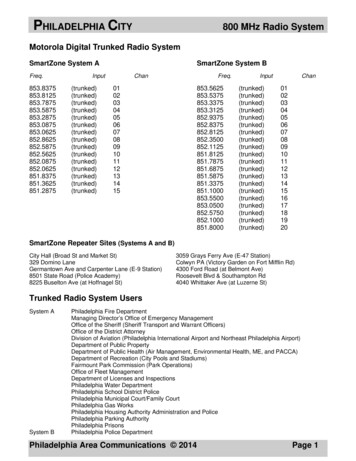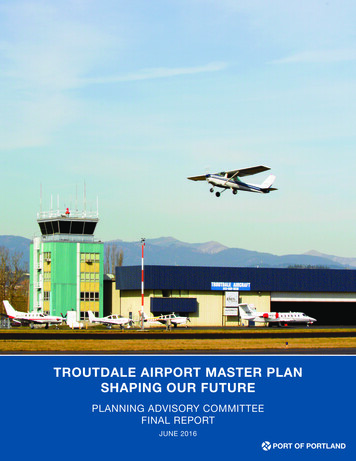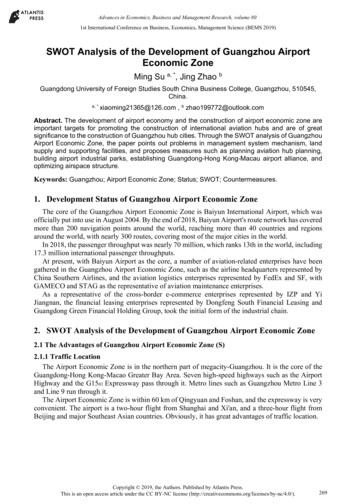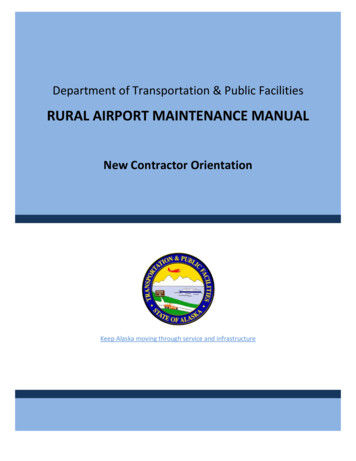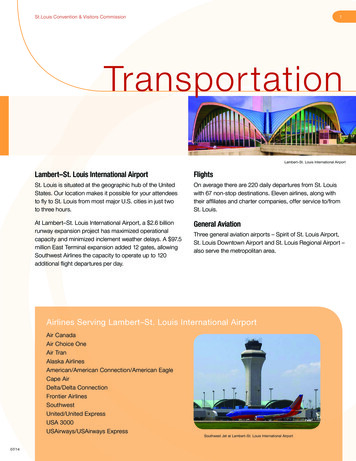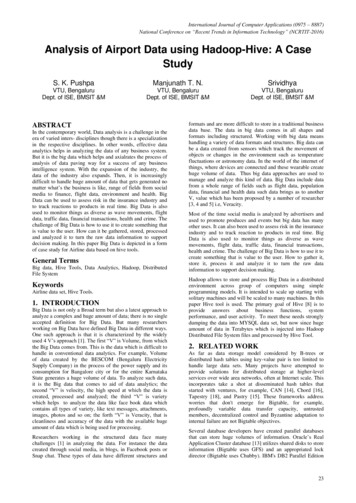
Transcription
International Journal of Computer Applications (0975 – 8887)National Conference on “Recent Trends in Information Technology” (NCRTIT-2016)Analysis of Airport Data using Hadoop-Hive: A CaseStudyS. K. PushpaManjunath T. N.SrividhyaVTU, BengaluruDept. of ISE, BMSIT &MVTU, BengaluruDept. of ISE, BMSIT &MVTU, BengaluruDept. of ISE, BMSIT &MABSTRACTIn the contemporary world, Data analysis is a challenge in theera of varied inters- disciplines though there is a specializationin the respective disciplines. In other words, effective dataanalytics helps in analyzing the data of any business system.But it is the big data which helps and axialrates the process ofanalysis of data paving way for a success of any businessintelligence system. With the expansion of the industry, thedata of the industry also expands. Then, it is increasinglydifficult to handle huge amount of data that gets generated nomatter what’s the business is like, range of fields from socialmedia to finance, flight data, environment and health. BigData can be used to assess risk in the insurance industry andto track reactions to products in real time. Big Data is alsoused to monitor things as diverse as wave movements, flightdata, traffic data, financial transactions, health and crime. Thechallenge of Big Data is how to use it to create something thatis value to the user. How can it be gathered, stored, processedand analyzed it to turn the raw data information to supportdecision making. In this paper Big Data is depicted in a formof case study for Airline data based on hive tools.General TermsBig data, Hive Tools, Data Analytics, Hadoop, DistributedFile SystemKeywordsAirline data set, Hive Tools.1. INTRODUCTIONBig Data is not only a Broad term but also a latest approach toanalyze a complex and huge amount of data; there is no singleaccepted definition for Big Data. But many researchersworking on Big Data have defined Big Data in different ways.One such approach is that it is characterized by the widelyused 4 V’s approach [1]. The first “V” is Volume, from whichthe Big Data comes from. This is the data which is difficult tohandle in conventional data analytics. For example, Volumeof data created by the BESCOM (Bengaluru ElectricitySupply Company) in the process of the power supply and itsconsumption for Bangalore city or for the entire KarnatakaState generates a huge volume of data. To analyze such data,it is the Big data that comes to aid of data analytics; thesecond “V” is velocity, the high speed at which the data iscreated, processed and analyzed; the third “V” is varietywhich helps to analyze the data like face book data whichcontains all types of variety, like text messages, attachments,images, photos and so on; the forth “V” is Veracity, that iscleanliness and accuracy of the data with the available hugeamount of data which is being used for processing.Researchers working in the structured data face manychallenges [1] in analyzing the data. For instance the datacreated through social media, in blogs, in Facebook posts orSnap chat. These types of data have different structures andformats and are more difficult to store in a traditional businessdata base. The data in big data comes in all shapes andformats including structured. Working with big data meanshandling a variety of data formats and structures. Big data canbe a data created from sensors which track the movement ofobjects or changes in the environment such as temperaturefluctuations or astronomy data. In the world of the internet ofthings, where devices are connected and these wearable createhuge volume of data. Thus big data approaches are used tomanage and analyze this kind of data. Big Data include datafrom a whole range of fields such as flight data, populationdata, financial and health data such data brings as to anotherV, value which has been proposed by a number of researcher[3, 4 and 5] i.e, Veracity.Most of the time social media is analyzed by advertisers andused to promote produces and events but big data has manyother uses. It can also been used to assess risk in the insuranceindustry and to track reaction to products in real time. BigData is also used to monitor things as diverse as wavemovements, flight data, traffic data, financial transactions,health and crime. The challenge of Big Data is how to use it tocreate something that is value to the user. How to gather it,store it, process it and analyze it to turn the raw datainformation to support decision making.Hadoop allows to store and process Big Data in a distributedenvironment across group of computers using simpleprogramming models. It is intended to scale up starting withsolitary machines and will be scaled to many machines. In thispaper Hive tool is used. The primary goal of Hive [8] is toprovide answers about business functions, systemperformance, and user activity. To meet these needs stronglydumping the data into MYSQL data set, but now since hugeamount of data in Terabytes which is injected into HadoopDistributed File System files and processed by Hive Tool.2. RELATED WORKAs far as data storage model considered by B-trees ordistributed hash tables using key-value pair is too limited tohandle large data sets. Many projects have attempted toprovide solutions for distributed storage at higher-levelservices over wide area networks, often at Internet scale. Thisincorporates take a shot at disseminated hash tables thatstarted with ventures, for example, CAN [14], Chord [16],Tapestry [18], and Pastry [15]. These frameworks addressworries that don't emerge for Bigtable, for example,profoundly variable data transfer capacity, untrustedmembers, decentralized control and Byzantine adaptation tointernal failure are not Bigtable objectives.Several database developers have created parallel databasesthat can store huge volumes of information. Oracle’s RealApplication Cluster database [13] utilizes shared disks to storeinformation (Bigtable uses GFS) and an appropriated lockdirector (Bigtable uses Chubby). IBM's DB2 Parallel Edition23
International Journal of Computer Applications (0975 – 8887)National Conference on “Recent Trends in Information Technology” (NCRTIT-2016)[12] depends on a shared-nothing [17] design like Bigtable.Each DB2 server is accountable for a subset of the columns ina table which it stores in a relational database. Both databasesafford a complete relational model with transactions. Thelimitation is that it is not scalable for huge amount of data asdata increases to a very larger extent. Hence apache hivesupports for huge amount of dataIn this paper Apache Hive is considered for analysing largedatasets stored in Hadoop's HDFS and compatible file systemssuch as Amazon S3 filesystem. It provides an SQL-likelanguage called HiveQL[9] with schema on read andtransparently converts queries to MapReduce, ApacheTez[10] and Spark jobs. All three execution engines can runin Hadoop YARN. To accelerate queries, it provides indexes,including bitmap indexes [11].Table 1: Airport Data Set [6]AttributeAirport IDNameCityCountryIATA/FAAICAOLatitude3. CHALLENGES IN BIG DATAThe uses of Big Data in various fields of knowledge areimmense in the sense its potentiality of micro and macrolevels of analysis of the data. For instance, the tools in BigData help the Institutions to study the quantitative andqualitative learning abilities of students from different strataof the society. Even the behavioral learning and thepsychological attitudes of the student may also be estimatedthrough the tools of Big Data. Big Data can also be used inanalyzing the cognitive abilities and the impact of health inacquiring the knowledge since health condition of the studentsusually affects on learning process.Further, the scope of big data is so vast that it has been used inglobalized urban societies in planning the locality, intelligencetransportation, air ambulance monitoring system, roadmapping, environment and natural disaster prediction.Big Data is supported by range of technologies such asHadoop [4]. Traditional relational data base skill are still inhigh demand but increasingly, so are the skills needed to workwith the generation of non-relational data bases known asNoSQL. These NoSQL data bases which are often opensource are built to handle the processing of large volumes ofdata and use different design strategies, architectures andquery languages. One of the biggest challenges in Big Data isBig Data analytics, where analyze examining and interpretBig Data.In this paper first tables were created for the below mentionedData Set [6]. The Data set was loaded into the created tableson an HDFS system. The Hive queries were applied and theresults were analyzed.4. ANALYSIS OF AIRPORT DATAThe proposed method is made by considering followingscenario under considerationAn Airport has huge amount of data related to number offlights, data and time of arrival and dispatch, flight routes, No.of airports operating in each country, list of active airlines ineach country. The problem they faced till now it’s, they haveability to analyze limited data from databases. The Proposedmodel intension is to develop a model for the airline data toprovide platform for new analytics based on the followingqueries.LongitudeAltitudeTimezoneDSTTz database timeDescriptionUnique OpenFlights identifier for thisairportName of airport. May or may notcontain the City name.Main city served by airport. May bespelled differently from Name.Country or territory where airport islocated.3-letter FAA code, for airportslocated in Country "United States ofAmerica"4-letter ICAO code.Decimal degrees, usually to sixsignificant digits. Negative is South,positive is North.Decimal degrees, usually to sixsignificant digits. Negative is West,positive is East.In feet.Hours offset from UTC. Fractionalhours are expressed as decimals, eg.India is 5.5.Daylight savings time. One of E(Europe), A (US/Canada), S (SouthAmerica), O (Australia), Z (NewZealand), N (None) or U (Unknown).See also: Help: TimeTimezone in "tz" (Olson) format, eg."America/Los Angeles". zoneTable 2: Airline Data Set yActiveDescriptionUnique OpenFlights identifier for thisairline. IDName of the airlineAlias of the airline. For example, AllNippon Airways is commonly knownas "ANA".2-letter IATA code, if available.3-letter ICAO code, if availableAirline callsign.Country or territory where airline isincorporated"Y" if the airline is or has untilrecently been operational, "N" if it isdefunct. This field is not reliable: inparticular, major airlines that stoppedflying long ago, but have not had theirIATA code reassigned (eg.Ansett/AN), will incorrectly show as"Y".The data description is as shown in Table 1 to Table 324
International Journal of Computer Applications (0975 – 8887)National Conference on “Recent Trends in Information Technology” (NCRTIT-2016)Table 3: Route Data Set [6]a)list of airports operating in the country India,AttributeDescriptionb)list of airlines having zero stopsAirline2-letter (IATA) or 3-letter(ICAO)code of the airline.c)list of airlines operating with code shared)list highest airports in each countryAirline IDUnique OpenFlights identifier forairlinee)list of active airlines in United StateSource airport3-letter (IATA) or 4-letter (ICAO)code of the source airportSource airport IDUnique OpenFlights identifier forsource airportDestination airport3-letter (IATA) or 4-letter (ICAO)code of the destination airport.Destination airportIDUnique OpenFlights identifier fordestination airport.Codeshare"Y" if this flight is a codeshare (thatis, not operated by Airline, butanother carrier), empty otherwise.5. METHODOLOGYIn this paper the tools used for the proposed method isHadoop , Hive and Sqoop which is mainly used for structureddata. Assuming all the Hadoop tools have been installed andhaving semi structured information on airport data [7, 8]. Theabove mentioned queries have to be addressedMethodology used is as follows:1.Create tables with required attributes2.Extract semi structured data into table using the loada command3.Analyze data for the following queriesa)list of airports operating in the country IndiaStopsNumber of stops on this flight ("0" fordirect)b)list of airlines having zero stopsc)list of airlines operating with code shareEquipment3-letter codes for plane type(s)generally used on this flight, separatedby spacesd)which country has highest airportse)listofactiveairlinesinUnitedStateThis paper proposes a method to analyze few aspects whichare related to airline data such asFig 1 Create and Load data set into HDFS25
International Journal of Computer Applications (0975 – 8887)National Conference on “Recent Trends in Information Technology” (NCRTIT-2016)Fig 2 List of airlines operating with code shareFig 3: List of airlines having zero stops26
International Journal of Computer Applications (0975 – 8887)National Conference on “Recent Trends in Information Technology” (NCRTIT-2016)Fig 4: List of airports operating in country India6. RESULTS AND DISCUSSION8. REFERENCESThis paper emphasize on data analysis on airline data set. Thepaper address the usage of modern analytical tool Hive on BigData set which focus on common requirements of any airport.Some of the instances are highlighted below with the samplesnapshots shown in Figure 1 to 4. Figure 1 shows the createtable and load data commands for HDFS system. It also givesnumber of Map and Reduce that are internally taken care bythe underlying tools of Hadoop System. Figure 2, 3 and 4shows sample queries that have been executed with Hive onHadoop. It is found that Hive is effective in-terms ofprocessing huge data sets when compared to traditional databases with respect to time and data volume.[1] tepaper.pdf7. CONCLUSIONThis paper addresses the related work of distributed data basesthat were found in literature, challenges ahead with big data,and a case study on airline data analysis using Hive. Authorattempted to explore detailed analysis on airline data sets suchas listing airports operating in the India, list of airlines havingzero stops, list of airlines operating with code share whichcountry has highest airports and list of active airlines in unitedstate. Here author focused on the processing the big data setsusing hive component of hadoop ecosystem in distributedenvironment. This work will benefit the developers andbusiness analysts in accessing and processing their userqueries.[2] -519135.pdf[3] Marta C. González, César A. Hidalgo, and Albert-LászlóBarabási. 5 June 2008 Understanding individual humanmobility patterns. Nature 453, 779-782.[4] James Manyika, Michael Chui, Brad Brown, JacquesBughin, Richard Dobbs, Charles Roxburgh, and AngelaHung Byers. May 2011 Big data: The next frontier forinnovation, competition, and productivity. McKinseyGlobal Institute.[5] Yuki Noguchi. Nov. 30, 2011 The Search for Analysts toMake Sense of Big Data. National Public earchfor-analysts-to-make-sense-of-big-data[6] course/big-data-and-hadoop[7] Manjunath T N et.al, Automated Data Validation forData Migration Security, International Journal ofComputer Applications (0975 – 8887), Volume 30–No.6, September 2011.(Imp act Factor 0.88)[8] Manjunath T N et.al, The Descriptive Study ofKnowledge Discovery from Web Usage Mining, IJCSIInternational Journal of Computer Science Issues, Vol. 8,Issue 5, No 1, September 2011 ISSN27
International Journal of Computer Applications (0975 – 8887)National Conference on “Recent Trends in Information Technology” (NCRTIT-2016)[9] HiveQL Language Manual[10] Apache Tez[11] Working with Students to Improve Indexing in ApacheHive[12] Baru C. K., Fecteau G., Goyal A., Hsiao H., Jhingran A.,Padmanabhan S., Copeland, To appear in OSDI 2006 13G. P., and Wilson W. G. DB2 parallel edition. IBMSystems Journal 34, 2 (1995), 292.322.[13] ORACLE.COM. ring/index.html.[14] Ratnasamy S., Francis P., Handley M., Karp R., andShenker S. A scalable content-addressable network. InProc. of SIGCOMM (Aug. 2001), pp. 161. 172.IJCATM : www.ijcaonline.org[15] Rowstron A., and Druschel P. Pastry: Scalable,distributed object location and routing for largescalepeer-to-peer systems. In Proc. of Middleware 2001 (Nov.2001), pp. 329.350.[16] Stoica I., Morris R., Karger D., Kaashoek, M. F., andBalakrishnan H. Chord: A scalable peer-to-peer lookupservice for Internet applications. In Proc. of SIGCOMM(Aug. 2001), pp. 149.160.[17] Stonebraker M. The case for shared nothing. DatabaseEngineering Bulletin 9, 1 (Mar. 1986), 4.9.[18] Zhao B. Y., Kubiatowicz J., and Joseph A. D. Tapestry:An infrastructure for fault-tolerant wide-area locationand routing. Tech. Rep. UCB/CSD-01-1141, CSDivision, UC Berkeley, Apr. 2001.28
Hadoop allows to store and process Big Data in a distributed programming models. It is intended to scale up starting with solitary machines and will be scaled to many machines. In this paper Hive tool is used. The primary goal of Hive [8] is to provide answers about business functions, system performance, and user activity.
